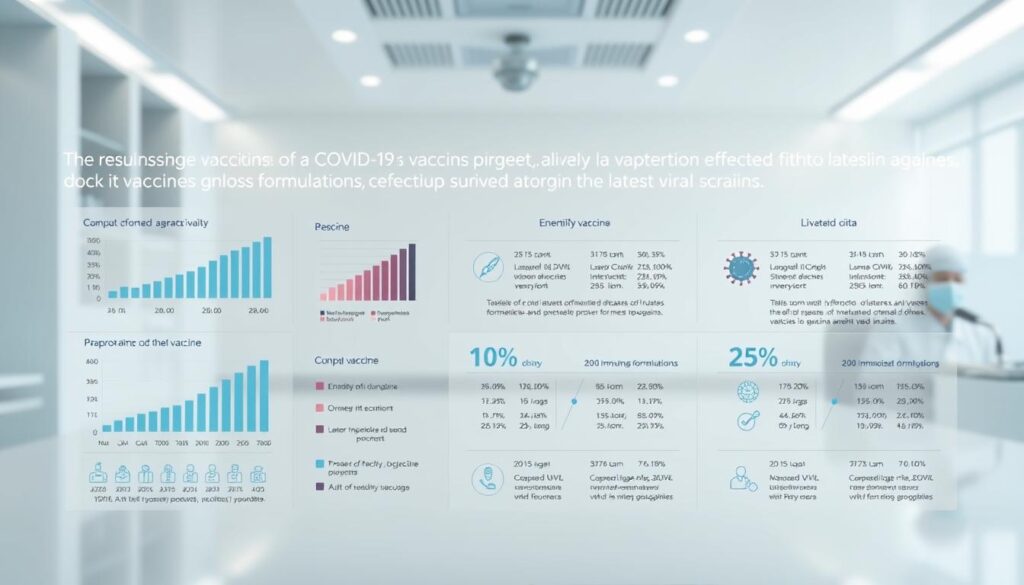Did you know hospital admissions linked to respiratory illnesses jumped 10% in just three weeks in parts of Europe? While testing has dropped globally, this spike highlights why health experts are tracking a recently identified strain called NB.1.8.1. Reports from Asia and confirmed cases in England suggest it’s gaining momentum—but what does this mean for you?
This guide cuts through the noise to explain how this strain differs from earlier ones. You’ll learn how its symptoms compare, whether vaccines still offer protection, and why reduced testing makes it harder to predict its path. We’ll also share practical tips to stay safe without overwhelming you with medical terms.
Right now, researchers are studying how quickly it spreads and whether existing treatments work. The good news? Early data suggests immunity from past infections or shots still helps. Staying informed lets you make smart choices for yourself and your family.
Key Takeaways
- A recently identified respiratory strain is causing increased hospitalizations in multiple countries
- Testing reductions worldwide make tracking its spread challenging
- Existing immunity may still reduce severe illness risks
- Symptoms appear similar to earlier strains but vary by individual
- Health agencies recommend updating vaccinations if eligible
- Simple precautions like mask-wearing remain effective
Understanding the new covid variant
Let’s break down what makes this recent development in respiratory health worth your attention. The NB.1.8.1 strain emerged as part of the virus’s natural evolution, showing how these pathogens adapt over time.
Origins and Formation
Scientists first detected NB.1.8.1 in January 2024 through genomic sequencing. This strain developed directly from the Omicron variant family tree – the same group that caused significant cases in 2022. Within three months, its presence in global samples jumped from 2.5% to 10.7%, showing faster spread than earlier forms.
Evolution From Previous Versions
While keeping Omicron’s basic structure, this version has specific spike protein changes. These tweaks might help it bypass some immune defenses more easily. Early research suggests existing vaccines still reduce severe illness risks, but protection against mild cases could weaken slightly.
The World Health Organization flagged it for special monitoring in May after noticing its growth pattern. This doesn’t mean panic – just that experts want closer tracking. You’ll see health agencies updating guidance as they learn more about its behavior.
Global Spread and Impact
Travel patterns tell an important story about respiratory illnesses today. Within months, what began as regional clusters has transformed into a worldwide health consideration affecting diverse populations.
International Perspectives and Case Trends
You’re seeing NB.1.8.1 appear in 22 countries across five continents. Asia reports the fastest growth, particularly in China and India where crowded cities help transmission. Europe’s situation shows complexity—while England confirmed 13 cases by June, hospital admissions rose nearly 10% there.
Australia’s experience proves even strict border policies can’t fully stop community spread. Multiple states there now track local transmission chains. This pattern mirrors early Omicron waves, though current case numbers remain lower overall.
Insights From Key Regions
In the U.S., LP.8.1 leads with 38% of cases, followed closely by NB.1.8.1 at 37%. Emergency visits increased 5.1% last week, though only 0.3% involved confirmed infections. This suggests other seasonal factors contribute to hospital pressures.
Health officials emphasize watching three metrics: wastewater levels, test positivity rates, and genomic sequencing results. These tools help compensate for reduced testing availability. Staying updated through local health alerts helps you make informed decisions about gatherings or travel plans.
Symptoms and Health Considerations
Recognizing early signs of respiratory illness helps you respond effectively. While many symptoms mirror common colds, this particular situation shows some distinct patterns worth noting.
What Your Body Might Tell You
A sharp, persistent sore throat often appears first – many describe it as “razor blades” when swallowing. This discomfort frequently comes with familiar companions like fatigue, low-grade fever, and mild coughing. Unlike earlier versions, some people also report stomach-related issues.
You might notice nausea or digestive changes alongside congestion. These gut symptoms don’t mean you’re in greater danger – they’re just different. Health authorities confirm this strain hasn’t caused higher hospitalization rates than previous ones.
Watch for these combinations:
- Throat pain lasting more than 48 hours
- Fever above 100.4°F with body aches
- Congestion paired with appetite loss
Seek medical care if breathing becomes difficult or symptoms worsen suddenly. Testing remains crucial for proper treatment plans. Remember, most cases resolve with rest and hydration – but knowing when to call your doctor brings peace of mind.
Vaccine Efficacy and Safety Protocols
Good news about your protection: health agencies confirm existing shots still pack a punch. The World Health Organization states the global risk level remains low, and your current vaccinations continue to shield against serious outcomes. Here’s what you need to know to stay ahead.

Effectiveness Against Severe Disease
Studies show updated formulations work like body armor for your lungs. Even if you catch this strain, vaccines slash hospitalization risks by keeping infections from turning dangerous. “The primary goal remains preventing life-threatening complications,” notes a recent WHO bulletin.
| Region | Eligibility | Timeline |
|---|---|---|
| United States | 6+ months | Fall 2024 |
| United Kingdom | High-risk groups | Early Winter |
| WHO Guidelines | All adults | Year-round |
Public Health Recommendations
Mark your calendar when updated shots arrive this autumn. The CDC urges everyone over six months to roll up their sleeves. Across the pond, UK health teams will first protect vulnerable populations before expanding access.
Your best defense? Combine past immunity with fresh vaccinations. This one-two punch helps your body recognize multiple threat patterns. Check local health department websites for appointment alerts in your area.
Data Analysis and Testing Procedures
Tracking respiratory illnesses has become trickier than solving a puzzle with missing pieces. Current methods rely heavily on three tools: lab reports, wastewater analysis, and genetic detective work. Let’s unpack how these systems help experts spot trends despite reduced visibility.
Testing Limitations and Genomic Sequencing
Standard nasal swabs tell you one thing – whether you’re infected. They can’t reveal which strain you’ve encountered. This gap creates blind spots for tracking specific versions like NB.1.8.1. Labs perform genomic sequencing to fill these gaps, examining the virus’s genetic blueprint like fingerprint analysis.
Only 1 in 20 positive samples currently gets sequenced in the U.S. This selective process helps health teams monitor changes without overwhelming labs. While less comprehensive than earlier pandemic efforts, it still provides crucial snapshots of circulating strains.
Monitoring Trends and Reporting
The World Health Organization coordinates global data sharing through platforms like GISAID. Recent reports show test positivity rates hovering at 3% – well below the 5% danger zone. Here’s what that means for your community:
| Positivity Rate | Transmission Level | Recommended Action |
|---|---|---|
| Below 5% | Controlled | Normal precautions |
| 5-10% | Moderate | Increased masking |
| Above 10% | High | Avoid crowded spaces |
Your at-home test results still matter. They help estimate overall infection rates when combined with hospital data. While you won’t learn the exact strain affecting you, regular testing remains your best tool for early detection and care decisions.
Public Response and Preventative Measures
Communities worldwide are adapting to evolving health challenges through smart, practical actions. While the situation changes, your daily choices still make a big difference in protecting yourself and others.
Smart Choices for Daily Life
Your best protection starts with combining vaccines with simple habits. Updated shots train your immune system to recognize multiple threats, while masks act as air filters in crowded spaces. Think of these steps as layers – each one adds more security.
Outdoor gatherings remain safer than indoor events. Fresh air dilutes potential risks, whether you’re at a park or backyard barbecue. When inside, open windows or use air purifiers to keep air moving.
| Action | Benefit | When to Use |
|---|---|---|
| Vaccination | Reduces severe illness | Every 6-12 months |
| Masking | Blocks airborne particles | Crowded indoor spaces |
| Hand Hygiene | Prevents surface spread | After public outings |
Staying home when sick shows care for your community. Even mild symptoms can spread the virus to vulnerable people. Quick tests help confirm infections so you can alert close contacts early.
“We have a lot of disease out there. People should continue to be careful. Get the bivalent booster, try to avoid high-risk settings.”
These strategies work because they target how respiratory illnesses spread. By focusing on airflow, cleanliness, and early detection, you create multiple barriers against infection. Health teams recommend reviewing your habits every few months as conditions change.
Conclusion
Staying ahead of respiratory illnesses requires balancing awareness with practical habits. While covid-19 variants continue evolving, your existing defenses still provide strong protection against severe outcomes. Health experts emphasize these strains are expected remain part of our global health landscape.
Simple actions make a real difference. Updating vaccinations when eligible helps your immune system recognize multiple threats. Wearing masks in crowded spaces adds another layer of safety, especially during peak seasons.
Remember, managing disease spread isn’t about perfection – it’s about smart choices that fit your life. Most people can stay protected by combining updated medical guidance with daily precautions like handwashing and avoiding crowded areas when possible.

